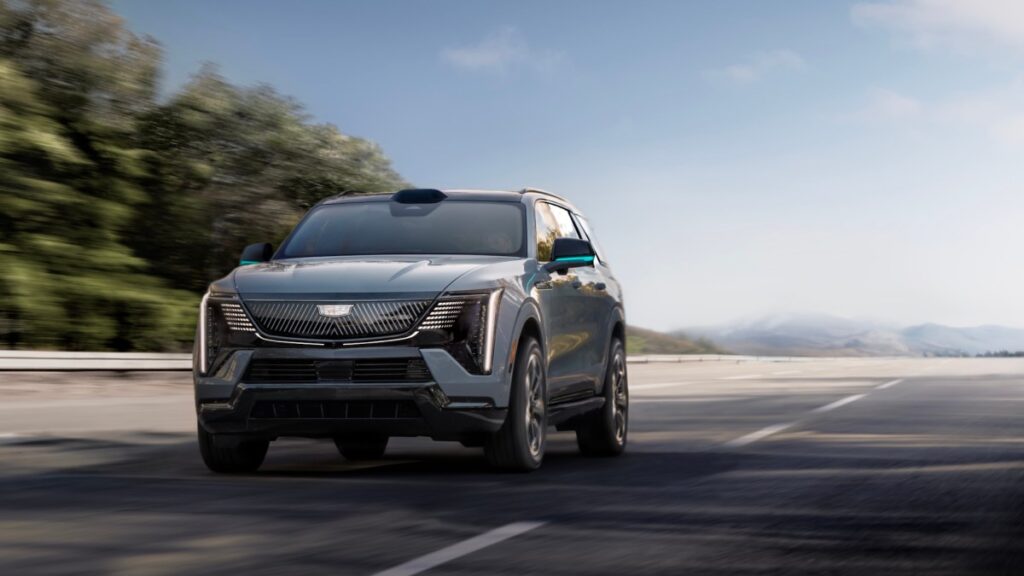General Motors is overhauling the electrical and computational underpinnings of its future vehicles to deliver faster software, more capable self-driving features and custom conversational AI assistants.
As a result of this overhaul, the Cadillac Escalade IQ will debut in 2027.
The US automaker, which announced its plans at an event Wednesday in New York City, said a new electrical architecture and centralized computing platform will underpin all of its future gasoline and electric vehicles from 2028 onwards. The next generation supercomputer, Nvidia Drive AGX Thor, will power the computing unit. This is the result of an expanded partnership between GM and Nvidia announced in March.
The internal upgrades are a necessary step as the company hopes to introduce more services and features, such as a conversational AI assistant and a system that allows the car to safely navigate the highway while the driver watches a movie. GM says both products are under development and will be introduced in future vehicles. It will also allow GM to improve vehicle performance, fix issues and add new features to infotainment systems through software updates, all of which will make it more competitive against the growing threat from Tesla and Chinese automakers.
Sterling Anderson, GM chief product officer, said that since joining the company in May, the company has been focused on accelerating the rollout of this new architecture because it “offers a number of benefits,” including bandwidth and “dramatic increases in computing power.” This is part of Anderson’s broader goal to get technologically advanced products into consumers’ hands faster.
“Going forward, in our core business, my focus has been on speed, product user experience, and profitability,” Anderson told TechCrunch. “We are looking company-wide to find opportunities to significantly reduce development time for vehicle platforms. Currently, development times are around four to five years, but we would like to get closer to two years.”
Most modern vehicles, including GM brands Buick, Chevrolet, Cadillac, and GMC, are equipped with numerous small computers that handle everything from infotainment and safety systems to propulsion, steering, and brakes. The number of these computers, called electronic control units or ECUs, has increased over the past decade as automakers add more services and features. By taking a radically software-first approach, Tesla was able to outperform established brands with more computing power and the ability to roll out new features and improve performance through wireless software updates, as well as iPhone and Android-based smartphones.
tech crunch event
san francisco
|
October 27-29, 2025
Traditional automakers have spent years and billions of dollars trying to catch up.
The industry widely agrees that part of the solution is to change the underlying hardware architecture to address the increasing computational demands of infotainment features, safety systems, autonomous driving, and more.
GM takes a similar, though not identical, approach to the zone architecture used by Tesla and Rivian. GM announced it will integrate dozens of ECUs into a unified computer core that will coordinate all subsystems in the vehicle in real time. This core is connected to three aggregators, hubs that convert signals from hundreds of sensors in the vehicle into a unified digital language and route commands to the correct hardware.
The result: A central computing platform connects all systems in the car, including propulsion, steering, braking, infotainment, and safety, via a high-speed Ethernet backbone.

GM calls the plan a “complete rethink” of how its vehicles are designed, updated and improved over time. GM claims the end result will be a vehicle with 10x more over-the-air software update capability, 1,000x more bandwidth, and up to 35x more AI performance for autonomy and advanced features.
GM has been on this path of software-centric vehicle reimagining for several years.
In 2020, GM rolled out a modern hardware architecture called the Vehicle Intelligence Platform (VIP) that enables increased data processing power and over-the-air software updates. The following year, GM announced a cloud-based, end-to-end software platform called Ultifi that executives promised would improve vehicle functionality and give drivers access to in-car subscriptions and new apps and services through over-the-air updates. The Ultifi branding has since been removed, but it is present on GM’s newest models and is software that runs on the VIP architecture. GM continued its bid for more software-centric vehicles in 2022, consolidating the dozens of computers used to operate the infotainment system onto a single computing platform.
GM says this latest move is based on all of this.
Source link

